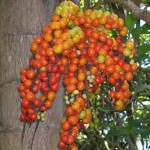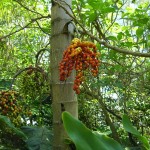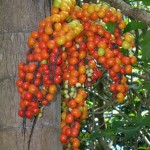Various Palm Seedlings At The Nursery
We’ve certainly had our share of strange winters in recent years. For instance, 2009-10 was remarkable for sustained cold. After an abnormally warm December 2009, January ushered in the coldest two-month period since 1940. There wasn’t much frost, except in the most interior districts of southern Florida, but persistent very cool days and nights eventually took a toll on many tropical plant species. Even large, mature specimens of Kapok (Ceiba pentrandra) and Tropical Almond (Terminalia catappa), including those near the coast, were so badly shocked that they did not leaf out until May. The Live Oak (Quercus virginiana), a mostly temperate zone native, reacted to the aberrant weather by fruiting profusely; the sound of acorns falling mimicked rainfall in some yards.
The winter of 2012-13 has proven unpredictable in its own way. November 2012 was cooler than normal, but the next three months were the third-warmest for that period in Miami’s recorded history. And following nearly the wettest summer in local history, the rain gauges ran nearly dry during that quarter. In likely reaction to those conditions, the white Shaving Brush Tree (Pseudobombax ellipticum) was seen beginning to flower as early as mid-December, about two months early, and at least one Royal Poinciana (Delonix regia) was observed flowering in January, presumably an act of perseverance from the preceding season.
But in March the atmospheric system that had been blocking cold fronts from reaching southern Florida shifted, and brisk winter weather invaded our region several times. As a result of the early- and late-season cool snaps, Tropical Almonds were tricked into producing beautiful red foliage twice in one season, a phenomenon that few people recall having seen before. A poem may not be as lovely as a tree, but, alas, some trees are very gullible.
But notwithstanding recent lurches, spring is inexorably on the way, and the folks at Richard Lyons’ Nursery are starting to look ahead by surveying some of the youngest plants on the property. Most are still in community pots, to be separated and repotted when soil temperatures become dependably warmer, but we want to present a few of them to the public. We start with palms.
Gaussia maya — This native of Mexico, Guatemala and Belize is a single-trunked, pinnate species. When young, it prefers protection from the sun, but as it matures, it can handle considerable exposure to light. It differs from most palm species in that it simultaneously produces flower stalks (inflorescences) up and down the trunk that ultimately bear attractive scarlet seed.
Coccothrinax cupularis — Many Coccothrinax species are noted for the fibers that surround the trunk, and that feature is particulary striking in this palm. The fibers tend to be fairly heavy and stiff and appear to be almost woven. They persist on the trunk for a number of years. This species is a reasonably fast-growing representative of the genus, too.
Coccothrinax guantanamensis — There is some uncertainty of the exact identity of this species, but the important ornamental fact is that it features a substantially thicker trunk than most other Coccothrinax species. Its dark green leaves and drought tolerance make it a very desirable plant for the landscape.
Pseudophoenix vinifera — This extraordinarily ornamental, slow-growing pinnate species is native to Hispaniola and was once used in the production of wine, but the process required the destruction of the tree. The palm features a graceful swollen trunk bearing ‘rings’ exposed whenever an old leaf falls off. It is quite drought-tolerant.
Copernicia berteroana — Copernicias are noted for very slow growth, but this species is considered one of the faster members of the genus. A mid-sized palmate species from Hispaniola, it is one of the few Copernicias not native to Cuba or South America. It should be grown in full sun, and while it appreciates moisture, it should be afforded good drainage. This is the only palm in our survey which has been in one-gallon containers since last summer.


